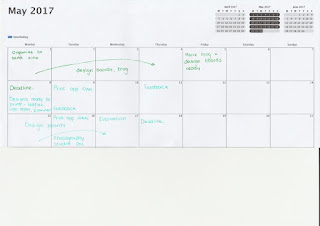The idea process for each of the studio briefs
was informed by varied and specific research as well as successfully gaining
feedback to aid the progression of each response. The decision to focus on the
Kirkgate Market fire was mainly informed by my own interest in the market, as
well as wanting to celebrate and represent the level of community and pride
that is shown through the people of Leeds. This decision was also informed by
being able to engage with the stall holders and visitors to todays market as
well as being able to experience the atmosphere and architecture of the market.
The decision to research and focus on the topic
of mental illness was informed by my recent studies via the Future Learn
course, Caring for people with Psychosis and Schizophrenia. This meant that I
was able to apply my own knowledge of the mental illness to the response as
well as be involved in a subject that I have an interest in. Due to having this
interest I was able to extend the response produced and therefore enjoyed the
completion of the self written brief.
This module has allowed me to explore my
interest in traditional print design as well as organizing documents for
digital print. Each of these methods allowed for experimentation in the print
areas which was aided through the support of workshop staff and tutorial
videos. This has taught me that using a range of information platforms is
important to receive a rounded and informed understanding of design.
Ensuring that a design is appropriate for screen printing is essential in
ensuring the print is successful. This meant that changes were made to the
point size of the vector drawings and the type size of the text in studio brief
01. These were consideration made when producing the design and therefore did
not affect the overall quality of the print.
Throughout the year I have been using the
digital print facilities and therefore have devised an efficient way to
printing. I ensured that all print slots were booked in advance of completion
of the module. This ensured that test prints were possible and therefore
suitable changes made. The documents were also checked thoroughly before
printing to ensure that no print errors were made. This is a routine that I
have been able to apply throughout my practice and has resulted in high quality
prints being produced, digitally and traditionally.
Carrying out primary and secondary research has
not only helped with printing but it has also developed my understanding of
social graphic design and how to design for a specific purpose/target audience.
This was of particular importance in Studio Brief 02 as the response to the
brief required an understanding of the audience and their needs. Speaking to
members of the target audience is an important element of completing a design
response to a problem. This is an identification that I have followed on with
from the Responsive OUGD503 Studio Brief 01 module. Comments from the target
audience led to the production and consideration of effective advertising of
the information pack. This was informed by the identification that not all
carers are aware of information platforms and they therefore need to be
effectively advertised to ensure the large target audience is being informed. Through
writing my own brief informed by the identification of the problem, it has
meant that I have been able to articulate my writing in an effective way to
ensure that clear aims and a direction were taken in the design response.
To finalize each studio brief I collaborated
with a pair of photographers (Hilda Quick and Charlotte Igoe) to gain high
quality images of the final outcomes. These are photographers I approached due
to their skills with studio. I was able to experience and practice my professionalism
through this collaboration as it involved communicating with the photographers to
organize the day of shooting as well as the organization of the photograph
compositions. As well as using the photographs for contextual and professionalism
references in the submission I will also be able to use them to post each
project on my social media pages. This is something that I have been completing
for each module to ensure that my work is being seen as well as to engage with
those artists who have influenced my practice.

































